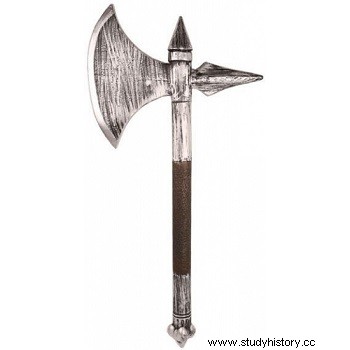
A hatchet is an ax whose use is that of a weapon and not a tool. It's a sizeable weapon. The design, very simple, takes up that of the tool, namely a generally curved blade plugged into a handle of variable size and nature.
The question of whether the tool preceded the weapon remains open because the two uses have coexisted since time immemorial
The expression "digging up the hatchet", which referred to a warrior practice of the Native Americans, took on a figurative meaning meaning the adoption of hostile behavior.
Technical evolutions of the weapon
A fairly common improvement is to use a double-edged blade, useless for technical use - felling trees, carpentry or carpentry - but which finds its meaning in the military context, allowing the weapon to be better balanced and to facilitate its use.
The addition of a point at the end of the handle allows thrusting, useful for piercing protection such as plate armor, which the edge of the ax would otherwise only damage, without succeeding in wounding its wielder seriously.
History of the use of battle axes
It has been used since prehistoric times, when it was made of stone and could also be used as a tool, especially when polished.
In antiquity, Greco-Roman priests used them to sacrifice oxen.
The lictors, in Rome, also carried axes surrounded by fasces.
It had its golden age with the Vikings who used large two-handed axes and the Franks.
It was gradually abandoned at the end of the Middle Ages in favor of the saber and the musket.
The double-edged ax has survived in particular in folklore and in the domain of heroic fantasy where it is the weapon of choice for dwarven warriors.
Examples of hatchets
Bardiche
Francisque
Lochaber's Axe
Halberd
Labrys
Tomahawk
